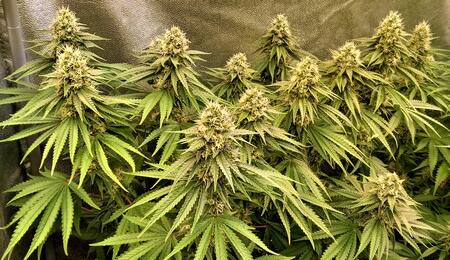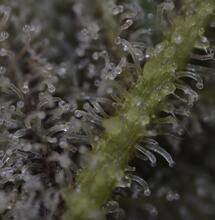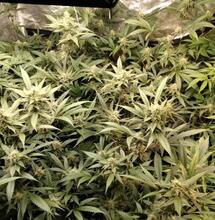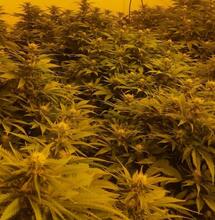10 Ways To Grow The Biggest Cannabis Yields

When it comes to growing top quality Cannabis buds for personal use, there is a fine line between yield and flavor. Ideally, you want to be able to produce a large enough crop without compensating for flavor, aroma and terpenes. In this article, we 10 ways to grow the biggest Cannabis yields indoors and what to consider.
1. Large yielding genetics
Starting with large yielding seeds will always give you an advantage when it comes to the final dry weight harvested. There are ways to enhance yields, however for a beginner grower, working with Cannabis seeds which are well known for large yields will be your best option.
- Hybrids will often be the most productive and will flower within 8–9 weeks.
- Combined with plant training, large yielding genetics can become enormous.
- Some strains perform better in a Sea of Green set up and yield large amounts.
2. Intense lighting
If you are new to growing Cannabis indoors, then one of the most important things to know if intense lighting is key. This basically means that when using an HPS, then anything below 600w will not produce the big buds, and 1000w HPS lights are ideal. When it comes to LED, the amount of watts and brightness is not what is required, however P.A.R.
- Avoid using 400w HPS setups, as these are only good for mothers and clones.
- Using HPS and metal halide lighting together is a good way to enhance the spectrum.
- Compact fluorescent lighting should only be used for cloning or mother plants.
3. Topping
This refers to a training technique which disrupts the growth hormone named Auxin, which is responsible for the vertical growth and apical dominance of the plant's structure. Topping Cannabis plants allows two crown shoots to grow instead of one, and, as a result, increases the final plant size and width, and produces a much heavier canopy.
- Topping should be done with a sharp and clean pair of scissors.
- It is best to perform this technique during the vegetative stage only (18/6).
- This technique can be applied many times, resulting in a high volume of buds.
4. Coco and perlite
If you have been growing with soil for years and are fed up with the small yields, then you can always try growing with coco and perlite, and using coco nutrients. Growing Cannabis in coco can be very rewarding in the yield department, and it is also a very grower friendly medium. Many growers swear by coco and find it the perfect point between organics and a hydroponic system.
- Roots love coco and will easily fill a pot in a short amount of time.
- Coco can be reused if necessary with the aid of enzymes.
- Many coco growers use dripper systems and achieve large yields.
5. L.S.T
Another training technique which allows a grower to manipulate the structure of the plant. The way this is done is by tying down the tallest part of the plant, and tying it down below the rest of the other side branches. As a result, the surrounding foliage will fight for apical dominance, causing a growth spurt. Within 3–5 days later, the tied down part has grown back upwards and now the plant has become a bushy cactus like plant with no main crown shoot.
- Low stress technique is also an excellent way to help reduce plant height.
- Tying down can be performed many times on different parts of the plants.
- L.S.T combined with topping can create a very large and bushy canopy.
6. Photo Active Radiation
P.A.R is what plants absorb and will dictate how many photos of light the plants receive. The actual brightness of a grow light which is measured in lumens is a redundant measurement when it comes to photo active radiation. LED lighting manufacturers are able to focus on producing the exact spectrum required for horticulture, and do not use the spectrums that plants do not need.
- LED lights should have a clear explanation of the P.A.R and PPFD.
- Make sure you do plenty of research before investing in expensive LEDs.
- Spectrums such as green and yellow are not important for Cannabis plants.
7. Felt Pots
Compared to traditional plastic pots, fabric pots typically made from felt allow the roots of the plant to breathe and encourage them to prune the roots. One of the most beneficial things about using felt pots is that the roots do not become root bound and actually grow out horizontally and back on themselves, causing a prolific root ball.
- Felt pots are easy to make and can be customized to whatever size you need.
- You can wash and reuse felt pots after each grow without needing to buy more.
- The roots of an air pruned plant will always be significantly greater than plastic pots.
8. Hydroponic Systems
Hydroponics can be hard work, expensive and sometimes an around the clock job depending on how large your operation is. However, the yields that are possible once you have dialed in your hydro systems and have wrapped your head around pH, E.C and drifting, can be two to three times larger than growing with soil!
- Dripper systems using a 15-minute segment timer are great entry level systems.
- Deep water culture can be the most expensive, but biggest yielding system.
- Commercial scale facilities will choose hydroponics out of practicality and labor.
9. SCROG
Those who are prepared to vegetate and train their indoor Cannabis plants for months at a time, will often find SCROG to be very beneficial when it comes to large yields. The Screen of Green set up basically uses a screen that sits over the plants, allowing them to be trained through the net. The goal is to fill every part with the net, and then prune all the lower canopy below the net.
- SCROG is an excellent way to grow an enormous plant with huge yields.
- This method is also a great way for growers to maintain a low plant count.
- The net can be made from wire or bamboo and is cheap to make at home.
10. Mycorrhizal Fungi
These beneficial fungi will attach themselves to the roots of a Cannabis plant in the form of a symbiotic relationship. From that point, the fungi will create a buffer between the soil food web and the root hairs of the plants, allowing them to obtain and uptake nutrients quickly. Using beneficial fungi can increase yields and also keep the root zone safe from harmful pathogens.
- Mycorrhizal inoculants are available in powder form, granular or liquid.
- The fungi will eat the carbon available in the growing medium as a food source.
- They can be added into the soil before planting or afterward.
Conclusion
There are many ways to grow large yields from starting with the ideal genetics, which grow lights you use, nutrients and plant training. On the basis that you follow this list, you should be well on your way to hitting new personal records come harvest time. Good luck growing those giant plants and monster yields!
Read more from Soft Secrets:
- Growing Cannabis Using Beneficial Microorganisms
- Growing Cannabis Inside Without Lights
- 12 Top Tips for Setting up an Indoor Grow Room






